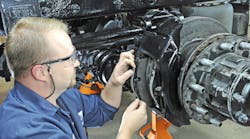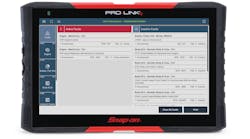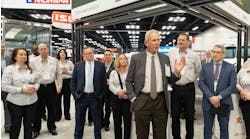An agreement signed last week between the Environmental Protection Agency (EPA), state governments and equipment trade groups serving the automotive and trucking industries will aim to reduce the amount of copper used in brake pads to less than 5% by weight by 2021 and then down to 0.5% by 2025.
In addition to copper, the EPA noted in a statement that this voluntary initiative also aims to reduce mercury, lead, cadmium, asbestiform fibers, and chromium-6 salts in motor vehicle brake pads.
Trucking and automotive trade group signatories to this agreement include: the Motor and Equipment Manufacturers Association (MEMA); Automotive Aftermarket Suppliers Association; Brake Manufacturers Council; Heavy Duty Manufacturers Association; Auto Care Association; Alliance of Automobile Manufacturers; Association of Global Automakers, Inc.; and the Truck and Engine Manufacturers Association.
The agreement derives from regulations passed in the states of California and Washington back in 2010 that mandated reductions in those brake pad materials, noted MEMA.
The group pointed out that because it's not financially feasible to sell vehicles with one type of brakes in only two states is why the Washington and California laws ended up altering the makeup of brake pads sold in North America.
However, some brake makers noted previously that such changeover in brake friction materials could create a possible “bump in the road” revolving around customer expectations for decreased noise, vibration, and harshness.
The EPA noted that the goal of this “copper-free initiative” is to decrease runoff of copper and those other materials found in brake pads from roads into the nation’s streams, rivers and lakes.
The agency noted that copper from storm water runoff can affect fish, amphibians, invertebrates and plants.
That same concern is what prompted Washington State to initiate its copper-free brake pad rulemaking, as a 2011 report from the Washington Department of Ecology estimated that about 21% of the copper that's deposited into Puget Sound annually – about 37 metric tons per year – resulted directly from brake pad runoff.
David Baldwin, a research zoologist at the federally-funded Northwest Fisheries Science Center, noted in that report that as little as five to 10 micrograms of copper per liter of water – a microgram being one-millionth of a gram – would be enough to hinder salmon's ability to find food or evade predators.
"Rather than outright killing the fish, it just renders them unable to smell," Baldwin noted. "For fish, smell is a really important sensory system."
EPA said that prior to California’s and Washington’s requirements, fine dust from vehicular braking released an estimated 1.3 million pounds of copper into California’s environment in 2010 and about 250,000 pounds into Washington’s environment in 2011.
Today, however, EPA said estimates from California show as much as a 61% reduction of copper in urban runoff in the Golden state due to changes in brake pad composition.



